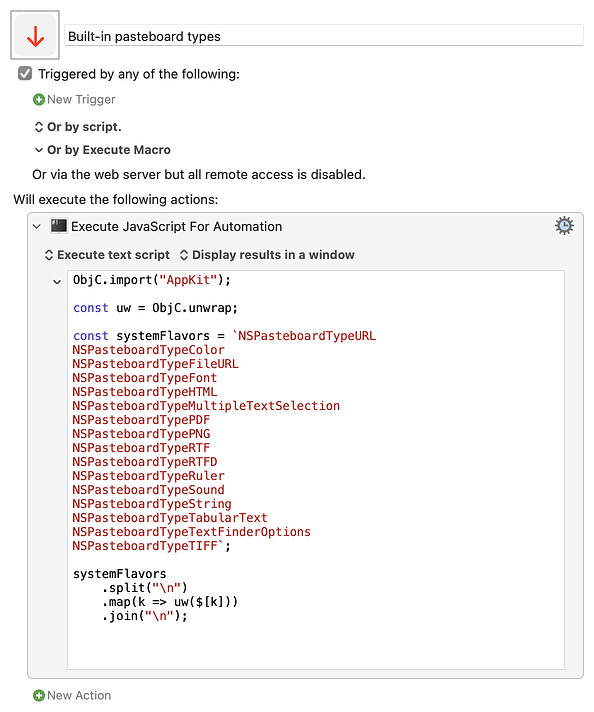Any application developer can define their own pasteboard types, and give them a string name, for example:
com.stairways.keyboardmaestro.macrogroupsarraycom.stairways.keyboardmaestro.macrogroupuidsarray
but the built-in types of data (KM "flavors") that the clipboard can hold are listed at:
Their direct name strings are:
public.url
com.apple.cocoa.pasteboard.color
public.file-url
com.apple.cocoa.pasteboard.character-formatting
public.html
com.apple.cocoa.pasteboard.multiple-text-selection
com.adobe.pdf
public.png
public.rtf
com.apple.flat-rtfd
com.apple.cocoa.pasteboard.paragraph-formatting
com.apple.cocoa.pasteboard.sound
public.utf8-plain-text
public.utf8-tab-separated-values-text
com.apple.cocoa.pasteboard.find-panel-search-options
public.tiff
which you can derive, in an Execute JavaScript for Automation action with:
Built-in pasteboard types.kmmacros (2.3 KB)
Expand disclosure triangle to view JS source
ObjC.import("AppKit");
const uw = ObjC.unwrap;
const systemFlavors = `NSPasteboardTypeURL
NSPasteboardTypeColor
NSPasteboardTypeFileURL
NSPasteboardTypeFont
NSPasteboardTypeHTML
NSPasteboardTypeMultipleTextSelection
NSPasteboardTypePDF
NSPasteboardTypePNG
NSPasteboardTypeRTF
NSPasteboardTypeRTFD
NSPasteboardTypeRuler
NSPasteboardTypeSound
NSPasteboardTypeString
NSPasteboardTypeTabularText
NSPasteboardTypeTextFinderOptions
NSPasteboardTypeTIFF`;
systemFlavors
.split("\n")
.map(k => uw($[k]))
.join("\n");
The key points to understand are that:
- Any application from which we copy can place several different pasteboard types (KM "flavours") in the clipboard at the same time, and
- the application into which we paste looks to see which "flavours" the clipboard contains, and selects one of them to use.
- We can sometimes override an application's default choice of which flavour to use, by deleting any competing flavours from the clipboard.
